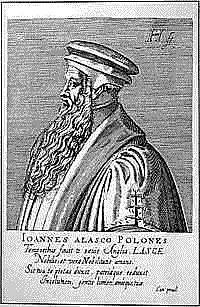3. Johannes a Lasco and East Friesland
 |
Johannes a Lasco |
Reformation activities arose in East Friesland as early as 1520, influenced
among other things by the “Devotio moderna.” Those convinced
of the Reformation received support in the larger towns (Emden, Norden,
Aurich and Leer) and from individual members of the chieftain nobility
(the regional rulers in East Friesland were called chieftains). By means
of the event of “the Oldersum Religious Colloquy” in 1526
(the themes in dispute were the mediation of Christ, the function of
Mary and the doctrine of justification) Ulrich of Dornum , above all,
caused a dispute between the approach to Reformation and Roman Catholic
theology. A further result of the colloquy was a distinctive profile
for Protestant positions in East Friesland. It is striking that the positions
of the Reformation in East Friesland are in the first place reminiscent
of Zwingli. Luther’s teachings, however, were felt as insufficient,
particularly in respect of the doctrine of the church.
In the year of 1528, the “Preachers’ Confession” arose,
in which it is denied that the sacraments are the means of salvation – the
authors thereby opposing Luther, whom they accuse of a lack of consistency.
This led to conflicts within East Friesland between the regional ruler Enno II, who out of political considerations gave precedence to the Lutheran positions, and the non-Lutheran circles, which at this point cannot yet be called “Reformed.” In 1540 Countess Anna took over the government businesses. By this time it was clear that two coexisting Reformation lines had formed in East Friesland: the Lutheran and the other, which would later be called Reformed. In the same year of 1540, Johannes a Lasco (1499-1560) had come to Emden. He came from the Polish nobility, was a pupil of Erasmus of Rotterdam and was theologically formed in Strasbourg and Zurich. In 1542 Countess Anna appointed this humanist Protestant foreigner to be Superintendent for all Protestants in East Friesland. He founded the “Coetus” in Emden, a weekly meeting of all the East Friesland preachers, and besides this, the Emden Church Council. He brought about the removal of some of the pictures from the churches and effected further church reforms. His main concern was to produce a common doctrine in East Friesland, among other things through the Emden Catechism of 1546, put together by him and his colleagues. But opposition against a Lasco arose – from the surrounding congregations, because he was in part too radical for them, and from the congregations of Lutheran character, for whom a Lasco was too Reformed. In 1549 a Lasco was dismissed at the instigation of Count John I, brother-in-law of the Countess Anna. A Lasco went to London and became the pastor of the Reformed who had fled from the Netherlands. Driven out from there, he returned with his congregation in 1553, without being appointed to his old position again, and worked together with (among others) the preacher Gellius Faber (who was theologically inclined more strongly towards Calvin) on the small Emden Catechism, which appeared in 1554, and which was in use East Friesland until 1888. In 1555 a Lasco was finally banished, because he appeared from the point of view of those governing to be too uncompromising. A Lasco went back over Frankfurt to Poland, where he attempted, without result, to unite the scattered Polish Protestants. In 1560 a Lasco died. In 1571 the synod of the Reformed Church of the Netherlands took place in Emden – outside the territory of the Netherlands in view of the bloody persecution of the Reformed that was taking place there – admittedly without the participation of the East Friesland congregations. The two Protestant confessions in East Friesland drifted apart in the second half of the 16th Century. Since 1575 Menso Alting, who was strongly influenced by Calvin, had been the pastor in Emden. He organised the East Friesland congregations in a Reformed manner by his “Order of the Coetus” of 1576, supported by Count John II, one of the two Counts of East Friesland. Against the opposition of the latter’s Lutheran brother, Count Edzard II, the citizens of Emden obtained for Emden its special position as an independent town in the Emden Revolution in 1595.
In 1599 the Concordat of Emden emerged, in which the coexistence of
the Reformed and Lutheran confessions in East Friesland was explicitly
set out. There was to be only one church in each place (either Lutheran
or Reformed), and Lutherans as well as Reformed in a particular place
would belong to this one congregation while maintaining their own confessional
position (= “East Friesland Special Right”). Although it
was broken after a while in the larger towns, Emden, Leer and Aurich,
this rule still exists in some of the villages today.
In the majority of Reformed congregations, an almost strict orthodox
Calvinism established itself, lasting into the 17th century. In some
places this was replaced by Pietist movements. The “awe of the
Lord’s Supper” (Abendmahlsscheu) – still known today,
(i.e. only very few go to the Lord’s Supper because they fear that
they are not worthy enough) goes back to this Pietist influence. Dutch
remained the church language into the 19th Century.
An invaluable source of knowledge of the development of the Reformed
confession in Emden and its surroundings is the unique Emden Church Council
Records, which are available also in printed form (published by Jan Weerda).
The Great Church in Emden was destroyed in the Second World War and is
today, after restoration, the Johannes a Lasco Library – a place
of research for Reformed Protestantism and a venue for a wide variety
of events.
The Reformed congregations in East Friesland belong today to the “Protestant
Reformed Church. Synod of Protestant Reformed churches in Bavaria and
North West Germany.” The office of the Synodal Council is located
in Leer, East Friesland.